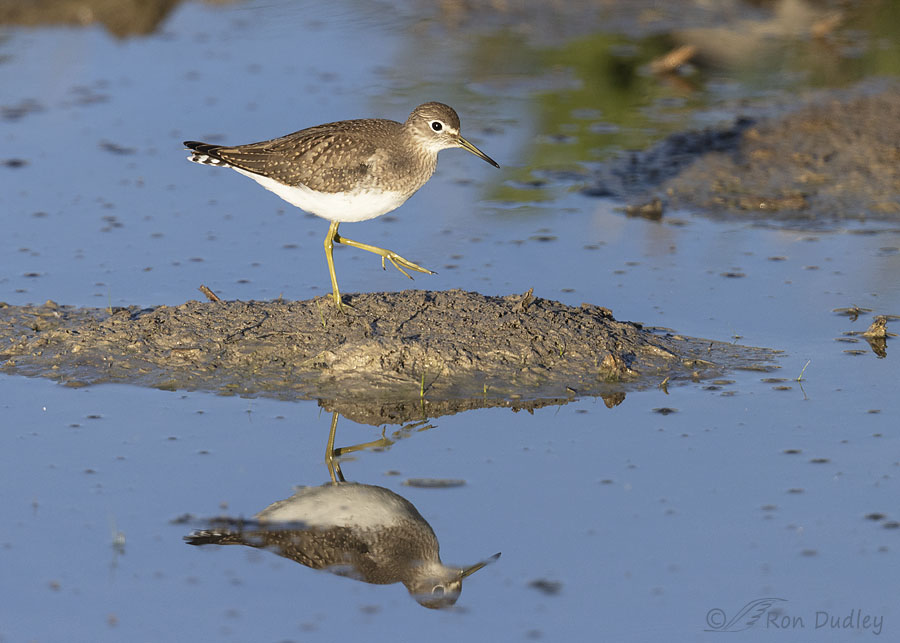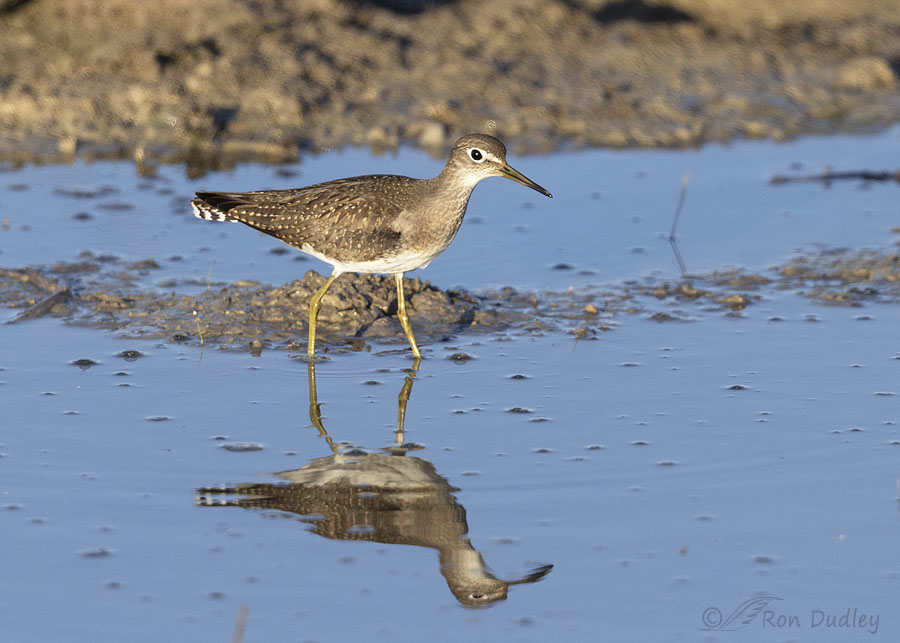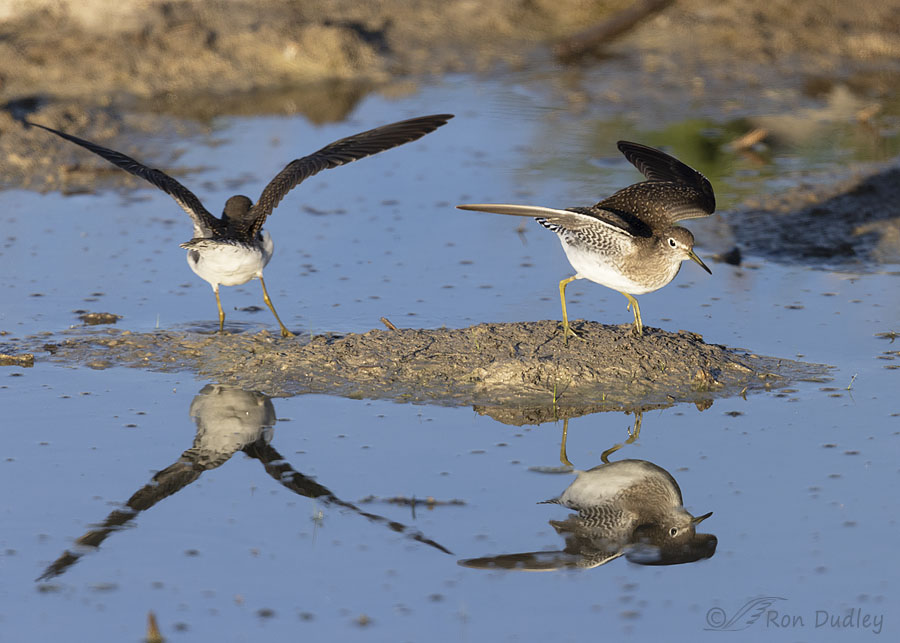A species I rarely see.

1/4000, f/5.6, ISO 800, Canon R5, Canon EF500mm f/4L IS II USM + 1.4 tc, not baited, set up or called in
I see and photograph Spotted Sandpipers fairly often but for me Solitary Sandpipers are darn close to a rarity, so I was pretty excited to photograph this one yesterday morning at Bear River MBR. My excitement was diminished only slightly when I discovered that none of my photos of this bird were quite as sharp as they should be.
I don’t understand why they were all a little soft, other than the fact that stuff like that happens to us bird photographers on occasion. Or maybe my old friend Murphy was lurking in the nearby cattails.

1/3200, f/5.6, ISO 800, Canon R5, Canon EF500mm f/4L IS II USM + 1.4 tc, not baited, set up or called in
I see this species so seldom I know little about them so last night while doing some research I was surprised to learn that of the 85 species of sandpipers in the world, only Solitary Sandpipers and palearctic Green Sandpipers routinely lay eggs in tree nests instead of on the ground. The thought of sandpipers nesting in trees kind of blows my mind.

1/3200, f/5.6, ISO 800, Canon R5, Canon EF500mm f/4L IS II USM + 1.4 tc, not baited, set up or called in
Their species name, solitaria, refers to their solitary habits in migration, which contrasts markedly with the flocking behavior of most other migrant sandpipers. But yesterday there were actually two Solitary Sandpipers foraging together and they’re obviously migrating so maybe they’re not so ‘solitary’ after all.
I never did manage to get any high-quality photos with both of them in the frame but this one documents that there were two of them together.
Ron


The first picture makes me think that the bird is an errant young of the year. Perhaps they are siblings exploring a new migratory route together. They are in the same genus as yellowlegs and have the same overall shape.
I hope, upon reflection, you will enjoy these more.
Running!
Great pics! Well, hopefully they don’t feel so lonely when they have their reflection to keep them company!
Made me smile, Elise.
How lovely! (Cool! Neat! Whatever the current phrase is.) These are definitely on the good side for documentary shots. (And, as EC said, many of us have ‘soft’ vision at this stage anyway so we’d never know the difference anyway . . . and yes, I know you would still know it). Like you I was surprised but glad to learn that there is one species that nests in trees.
Tree-nesting sandpipers certainly surprised the heck out of me, Granny Pat.
You mean peachy keen is out of style? Drat!
Learning all the time. Thank you. And, like Wally, my eyes are soft. Too damn soft which obviously has its benefits.
Thanks, EC.
wonderful shots Ron, thanks for sharing!
Charlotte Norton
Thanks, Charlotte.
Beautiful photographs to my “soft” eyes!
We’re looking forward to seeing these handsome birds and their relatives as migration gets underway.
Sounds like you might see them regularly, Wally. If so, I’m jealous.
Early ornithologists and even Audubon assumed these birds nested on the ground as other sandpipers do. Nests of Spotted Sandpipers were often misidentified as belonging to Solitary Sandpiper. The first documentation of tree-nesting did not happen until 1903. Old American Robin nests are most often used but several other passerine species have now also been documented. An interesting species with many interesting behaviors.
“The first documentation of tree-nesting did not happen until 1903.”
Interesting that it took them that long.
I should have mentioned that the discovery was not by a known ornithologist. The first nest was collected by a 16 year old Scottish immigrant who collected and sold eggs for extra income. Egg collecting was a popular hobby at that time. By 1906 he had collected 4 nests and sets of eggs of Solitary Sandpiper.
Very interesting Ron – I often come across a solitary Sandpiper around one of our lakes here. In fact more often than not I come across one alone rather than a pair or more. I did come across one recently in a creek as well. I had no idea that Sandpipers have nests in trees. Really never thought about where they might lay their eggs, but definitely not in trees.
Everett, Solitary Sandpipers use “abandoned nests of arboreal passerines, particularly American Robin, Rusty Blackbird, Eastern Kingbird, Gray Jay, and Cedar Waxwing.”
Neat! 🙂 Not sure if that’s what we have on the creek at the moment or not – they are solitary and have yellow legs. We only see them this time of year when the creek has quit running. Will have to get the binoculars out. 😉 The idea they nest in trees IS mind blowing.
Judy, I’ll bet you’re seeing Greater Yellowlegs, or possibly Lesser Yellowlegs, on your creek.
That was my first thought and, probably one or the other of those…….THX!
Thanks for posting this. It gives me a chance to study their identifying features. If I had seen it I probably would have thought it was a Lesser Yellowlegs. It seems to me Sandpoker would be a more descriptive word; although Sandpiper is certainly more mellifluous but descriptive only if they’re close enough to hear.
Ha, at first I thought it might be a Lesser Yellowlegs too, Lyle. For a minute I also considered Spotted Sandpiper but it didn’t take long to rule that out. I just didn’t expect Solitary Sandpiper.
Different subjects make interesting pictures and new information from you. I like the reflections, particularly.
Thanks, Nancy.
Once again. Learning and enjoying photos of birds.
The nesting in tree thing is curious, as well as the solitary migration thing. Presuming they all migrate from one general location to another, it begs the question, how far apart must two sandpipers be to be considered solitary?
That last photo would appear to have captured the moment when these two decided that they were just too close together.
“these two decided that they were just too close together.”
That’s exactly what happened, Michael. The bird on the left landed on the same little ‘island’ as the other sandpiper and these were their reactions when they both apparently thought they were too close to each other. But neither bird flew off.
The literature actually says that they “occasionally” migrate in pairs or very small groups but usually they migrate alone.
I never see them so thanks so much! And you are such an artist but I think they are quite high quality!
Thanks, Mary. They look better at this low resolution than they really are.